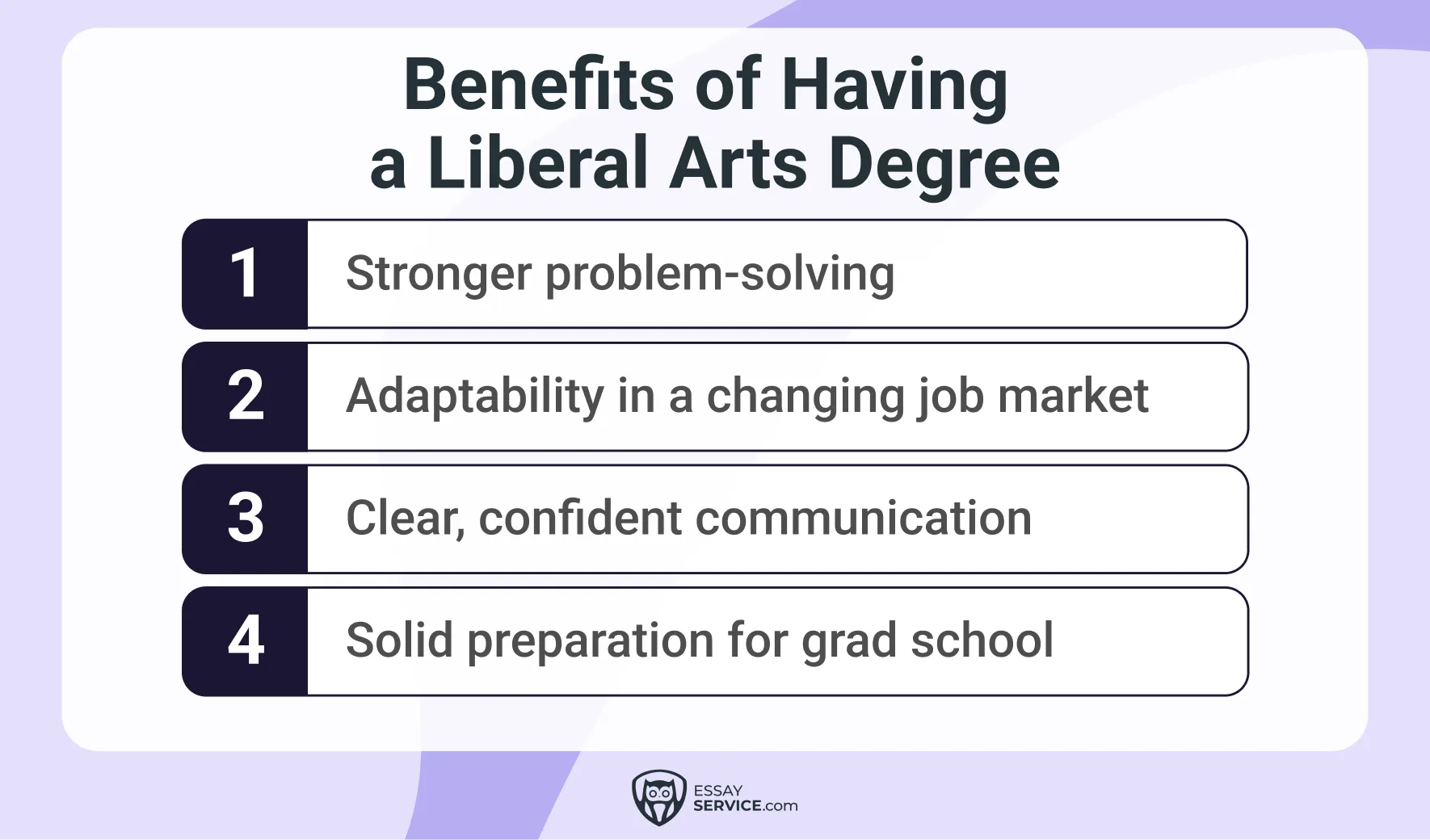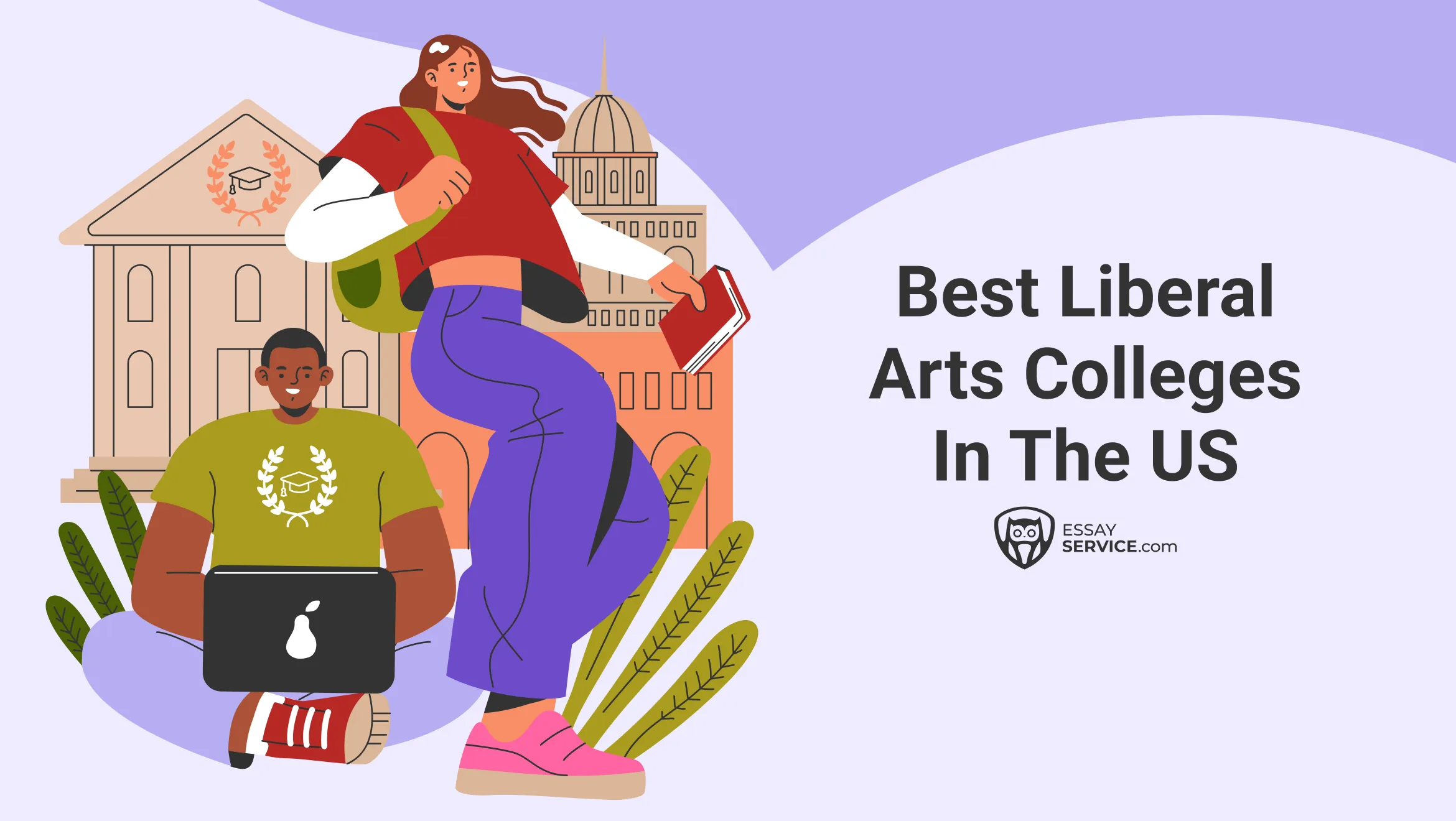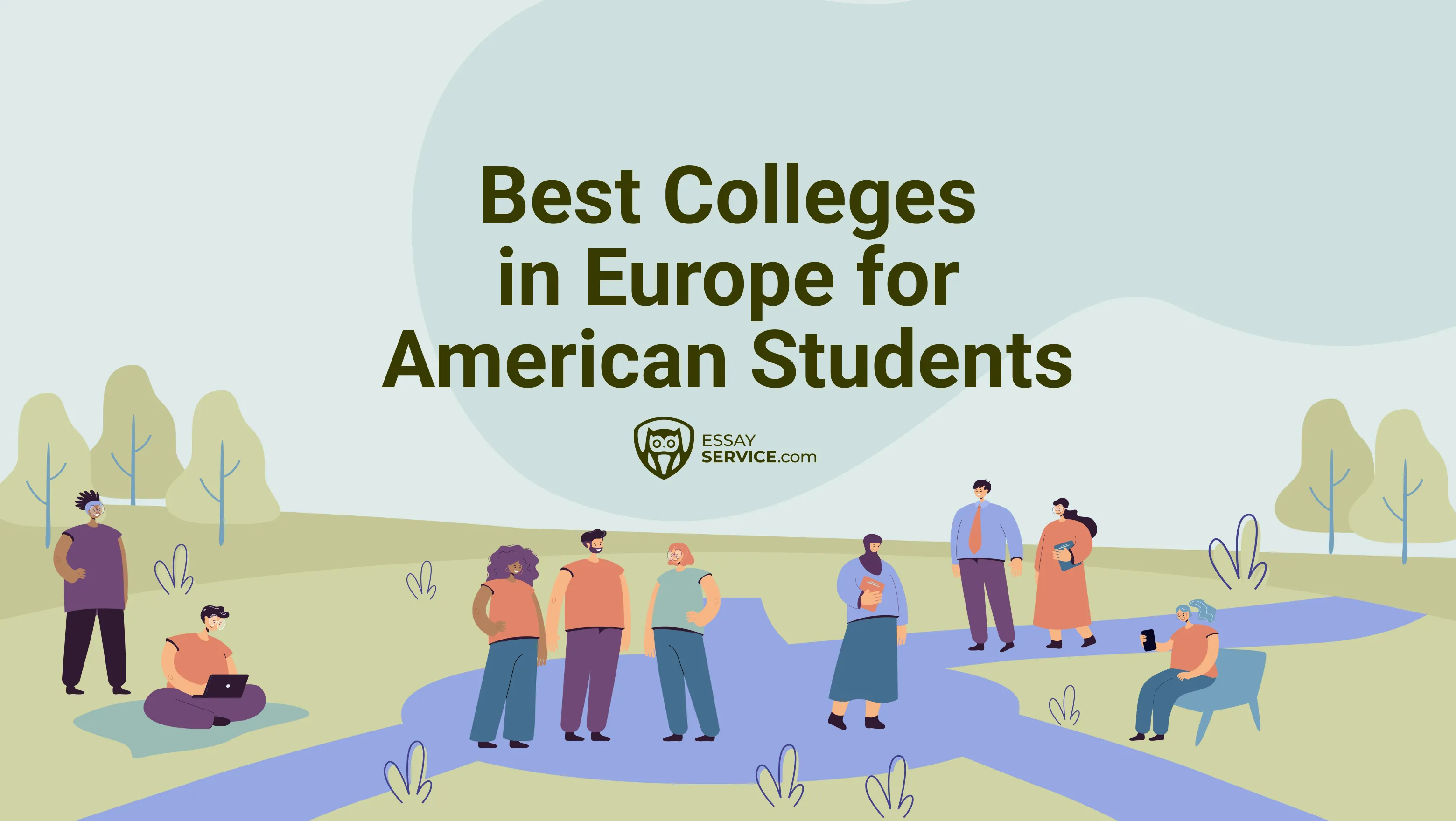A liberal arts degree is a broad bachelor’s program that includes coursework across the humanities, social sciences, natural sciences, and related interdisciplinary fields.
Below is a quick list of good liberal arts colleges in the US:
- Williams College
- Amherst College
- Swarthmore College
This article will give you a clear overview of US liberal arts college rankings, helping you understand what liberal arts education really looks like and how each program works. And if you’re stuck in the application process, EssayService can help you with admissions and college essays, as well as future assignments related to your program.

What Is a Liberal Arts Degree?
A liberal arts degree is a broad-based bachelor's degree that includes humanities such as literature, philosophy, and languages; social sciences such as psychology, sociology, political science, and economics; and natural sciences, including astronomy and environmental sciences.
People with liberal arts education move into fields like journalism, marketing, public relations, consulting, public policy, education, UX research, HR, communications, grant writing, publishing, museum work, design strategy, project management, and social work.
Top Liberal Arts Colleges in the US
Before choosing a program, take a moment to think about yourself. Notice which subjects you study on your own, which type of work feels more natural for you, and what kind of future you want your degree to support. Once you have those answers, then consider these US liberal arts colleges ranking:
- Williams College
- Amherst College
- United States Naval Academy
- Swarthmore College
- Bowdoin College
- United States Air Force Academy
- Claremont McKenna College
- Pomona College
- Wellesley College
- Carleton College
In the following sections, you will find everything you need to know about each program.

Williams College
Williams is consistently ranked at the top of the polls for national liberal arts colleges. According to its own data, the student-faculty ratio is 7:1, which means small classes with tight interaction between students and professors.
Students report that Williams fosters critical thinking, effective writing, creative exploration, and academic rigor. Because of the small size and emphasis on teaching, you’ll often work closely with professors, explore ideas in seminars rather than massive lecture halls, and have a curriculum designed for undergraduates.

Amherst College
Amherst is known for its strong liberal arts education and academic excellence. The college’s reputation and academic quality hold weight across the country and the world. Because it’s a small college campus with an elite reputation, it gives you access to big-school prestige plus small-school teaching and attention.
You also get their open curriculum, which is rare among the best liberal arts colleges. You won’t be forced through cookie-cutter 'core requirements.' Instead, you build your own map. This is a huge plus if you have already figured out what exactly you want to study.

United States Naval Academy
The United States Naval Academy (USNA) in Annapolis isn’t a traditional liberal arts school at all. It’s one of the five federal service academies that trains future officers for the U.S. Navy and Marine Corps. The academy includes courses in the humanities and social sciences, but the overall program is not structured as a traditional liberal arts degree.
Here, you study social sciences and humanities because they shape you into a more capable officer. The teaching style is different, too. Small classes exist, but the environment is structured and hierarchical. Discussions happen, but within the disciplined culture of a military academy.

Swarthmore College
Swarthmore is a small, very intense liberal arts college in Pennsylvania. You take advanced seminars, work closely with professors, and then your work is evaluated by external examiners (academics from other universities). Swarthmore offers a true liberal arts education, deep in the humanities, social sciences, and natural sciences, while also being one of the few liberal arts universities that includes a full engineering program.
If you like the idea of strong teaching + strong resources in a liberal arts context, not just traditional humanities but with science, engineering, and global options, Swarthmore might be the right choice for you.

Bowdoin College
Bowdoin is a private liberal arts college in coastal Maine. The small classes and direct access to faculty make it easy to dive deeply into anything from environmental studies to philosophy to government. The school has a surprisingly strong science and research culture for its size, yet it preserves the essence of the liberal arts: reading, discussing, thinking, and writing.
The college also has great study abroad options, strong financial resources, and a loyal alumni network that takes care of its own. Employers know Bowdoin produces graduates who can think clearly, speak well, and adapt fast, which is exactly what career opportunities are built on.

United States Air Force Academy
This is the second on our list of liberal arts programs that seems to have little to do with the liberal arts. But let’s look closer. The United States Air Force Academy is a federally funded military academy in Colorado Springs that trains officers for the U.S. Air Force and Space Force.
Military academies offer liberal arts education because war, leadership, diplomacy, intelligence, and strategy are human problems before they are technical ones. The academy uses liberal arts to build judgment, communication skills, and strategic thinking, which are qualities that no amount of engineering or weapons training can replace.

Claremont McKenna College
Claremont McKenna provides a strong liberal arts foundation, particularly in the social sciences, economics, and government. CMC stands out because it primarily focuses on economics, government, international relations, data-driven social sciences, and related fields.
Students pair the liberal arts education with real-world research through its research institutes, such as the Rose Institute of State and Local Government or the Keck Center for International and Strategic Studies.
The college is known for preparing students in law, consulting, government, business, NGOs, tech, and policy roles.

Pomona College
Pomona is a top-tier national liberal arts college in Southern California with Ivy-level academics, small classes, and a campus built entirely around undergraduate teaching.
Majors range across the full spectrum: history, physics, linguistics, politics, math, philosophy, environmental analysis, computer science, and more. Pomona students take risks and combine fields. They jump into research, study abroad, and interdisciplinary projects.

Wellesley College
Wellesley is a top national liberal arts college for women and is one of the most respected institutions in the country. The college is part of the ‘Seven Sisters’, the historic counterpart to the Ivies. The gender distribution is 1.7% male students and 98.3% female students.
Wellesley consistently appears in the best liberal arts colleges in the US because it pairs depth with opportunity: small classes, extraordinary professors, strong financial resources, and a tight community that doesn’t blur into a giant university the way some co-ed colleges do.

Carleton College
Carleton is a national liberal arts college in Northfield, a classic college town that’s small, safe, friendly, and designed around student life.
You’ll often find Carleton in the ranking of liberal arts colleges as one of the best, especially for strong career opportunities, faculty-student relationships, excellent scholarships and aid, and research options typically found at bigger universities.
Benefits of Having a Liberal Arts Degree
A liberal arts degree has a reputation for being 'broad,' but the practical value shouldn’t be underestimated. Here’s what a degree in liberal arts will get you.

- You become better at problem-solving: Liberal arts trains you to read a situation that doesn’t follow a neat formula and break it down until you figure out the solution. That’s useful in consulting, management, tech, policy, marketing, journalism, and any job built on judgment.
- You handle career changes better than specialists: Automation reshapes entire fields, so adaptability becomes a major advantage.
- It makes you a strong communicator: Most graduates are not, and employers know it. If you can send clear emails, give a solid presentation, write clear reports, and explain decisions convincingly, you already stand out. That’s why liberal arts grads are common in leadership tracks.
- You get strong prep for grad school and competitive careers: Law, business, public policy, education, data-driven programs, international relations, and even medicine with the right prerequisites. Liberal arts is a launchpad.
The Bottom Line
The schools you’ve been looking at, like Williams, Amherst, Swarthmore, Pomona, Bowdoin, Carleton, Wellesley, and the major service academies, each take the liberal arts idea and shape it to their own culture. Some lean into pure academics or into leadership. Others weave science and the humanities together, and a few can even bring in military discipline.
If you’ve already found your dream school, EssayService can help you with the application process. Our college essay writing services have helped thousands of students and provided ongoing support throughout their college years.
FAQs
How Many Liberal Arts Colleges in the US?
There is no exact number, but most estimates place the current count at roughly 180–200 private liberal arts colleges.
What Is the Best Liberal Arts College in the US?
Williams College is often listed at the top of the best liberal arts colleges in the US. They have exceptional academic quality and strong undergraduate teaching, and a small student-faculty ratio adds value.
What Is the Hardest Liberal Arts College to Get Into?
There’s no single institution that everyone agrees on being the hardest to get into, but several schools are at the top of the list. For example, Pomona College and Swarthmore College both admit about 7% of their applicants.
What Are the Top Liberal Arts Colleges in the US?
Here are some of the most consistently ranked schools:
- Williams College: rated #1 by some rankings
- Amherst College: often in the top 5
- Swarthmore College: small-class environment and very high ranking
- Pomona College: elite West Coast liberal arts college
- Bowdoin College: strong reputation and high ranking among arts colleges
Are Liberal Arts Colleges Worth It?
Yes. If you care about an education that builds you into someone who can think, adapt, communicate, and problem-solve at a high level, a liberal arts college is definitely worth it.

Phil spends his working days teaching international trade. He contributes to our blog as a freelancer, leveraging his experience with MBA students to advise on academic writing, studying abroad, and securing funds.
- Council of Public Liberal Arts Colleges. (n.d.). Why a liberal arts education. https://www.coplac.org/why-a-liberal-arts-education
- Southern New Hampshire University. (2024, July 31). What is a liberal arts degree and what can you do with it? https://www.snhu.edu/about-us/newsroom/liberal-arts/what-is-a-liberal-arts-degree
- Laine Perfas, S. (Host). (2024, October 9). “Harvard Thinking”: What skeptics get wrong about liberal arts [Audio podcast]. Harvard Gazette. https://news.harvard.edu/gazette/story/2024/10/the-true-value-of-college-a-liberal-arts-education-podcast-harvard-thinking/



